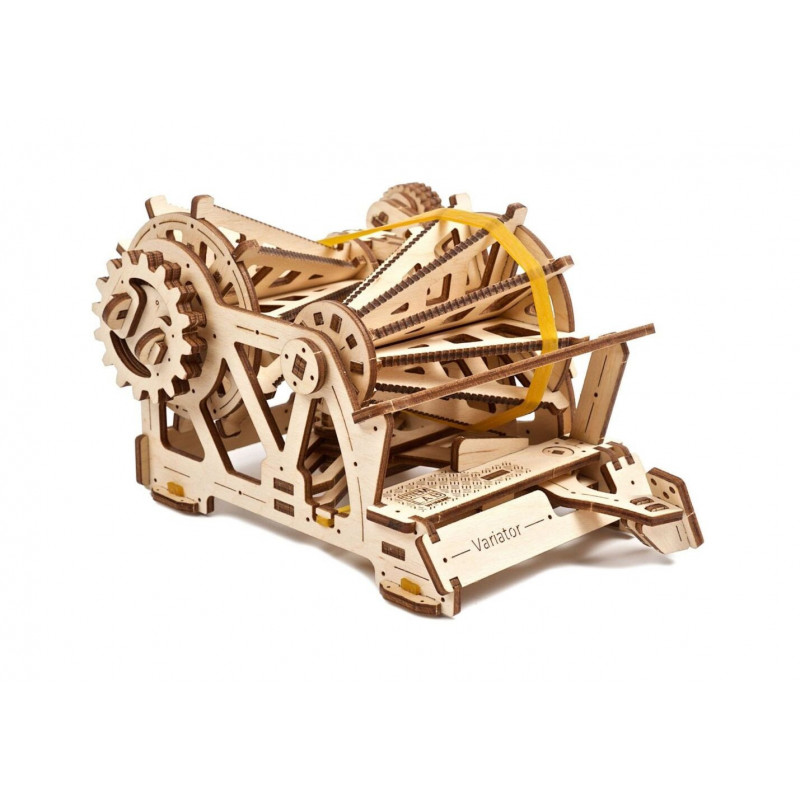EDUCATIONAL STEM LAB MECHANICAL MODEL TO ASSEMBLE
Assemble the model and discover the principle of the Variator.
Experiment: included is a pocket guide with the history of the creation of the Variator and interesting tasks.
Immerse yourself in virtual reality and learn how the Variator works; test how the Variator works using the dedicated UGEARS AR app.
With the dedicated app, you will be able to learn even more about the built model.
UGEARS AR is available on Google Play Market and Apple Play Store.
LEARN MORE ABOUT THE VARIATOR
A variator is a device that transmits and regulates engine torque by changing the gear ratio. The gear ratio can change automatically, manually or within a pre-set program. The term with which most drivers and car enthusiasts are more accustomed is continuously variable transmission, or CVT. With Ugears' variator model from the STEM lab collection, you can learn and understand one of the most important parts of a car without getting your hands dirty with machine oil!
Who invented the variator and when
The roots of the modern car CVT date back to 1879, when American entrepreneur and automotive pioneer Milton Othello Reeves invented a device for use in a sawmill, which he then called a variable speed transmission. He later began installing this transmission in his cars. Reeves' CVT transmission was also used by several other manufacturers.
Application
The CVT transmission is used in mechanisms where continuous ranges of gears need to be changed smoothly: cars, scooters, snowmobiles, quadricycles, conveyors, metal-cutting machines, etc. To get a better idea of how it is used in different types of equipment, try the AR app that comes with the Ugears STEM model.
The design of the variator and how it works
The mechanical variator from the Ugears STEM lab collection is a fully functional, wooden replica of a belt-driven CVT bevel gearbox. A conical CVT transmission changes the drive ratio by moving a wheel or belt up and down the axis of a conical cylinder. On the Ugears Variator model, a belt, driven manually by a reducer, transmits rotation to the driven cone pulleys. Using a gear fork, change gears and watch the speed of the driven cone pulley decrease or increase, while the speed of the driven cone pulley remains the same. Because of the open design of the model, you will be able to see the entire process.
The Variator mechanism consists of:
- key
- drive cone pulley
- drive cone pulley
- reducer
- belt
- pedal
- casing
- transmission forks
Ugears STEM models have been designed with different age groups in mind, with special emphasis on the educational component. Assembling the model will be interesting and will not take much time.
As with the rest of the Ugears collection, assembling STEM lab models is fun and extensive: everything you need to build, learn and explore is in the box. You'll find:
- Wooden details pre-cut with a precision high-tech laser into high-quality plywood panels, as well as other materials necessary for assembly. The models do not require glue or additional building tools. The details come out of the board when lightly pressed.
- Illustrated step-by-step assembly instructions.
- Practical laboratory tasks using your model.
- QR code to download a pocket guide about your model, its mechanism, principle of operation, main features, physical and mechanical formulas and fun practical tasks.
- QR code to download the AR app. A fascinating innovation from Ugears - a new drive to learn more new things !
Additional information:
- Difficulty level: 1 easy
- Number of parts: 104
- Dimensions of the model: 17 x 13 x 11 cm
- Assembly time: 3 - 4 hours


















